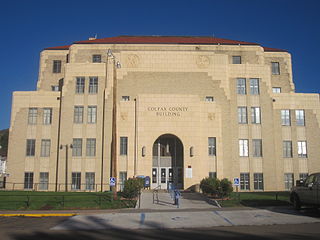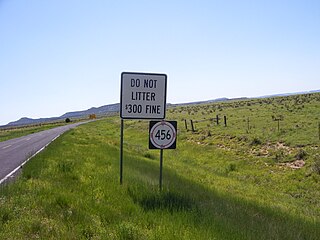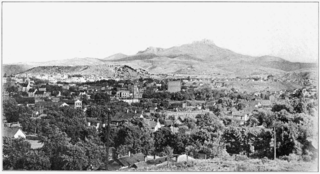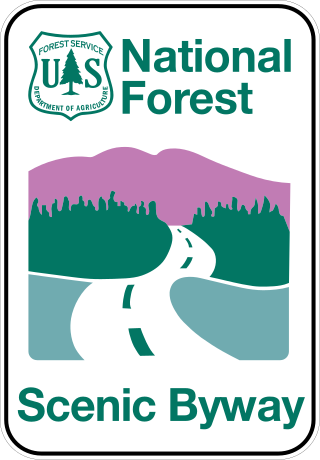
Johnson Mesa is a prominent mesa in Colfax County in northeastern New Mexico just south of the Colorado border. The city of Raton is on the west and the community of Folsom on the east.

Johnson Mesa is a prominent mesa in Colfax County in northeastern New Mexico just south of the Colorado border. The city of Raton is on the west and the community of Folsom on the east.
Johnson Mesa is about 14 miles (23 km) long, running east to west, and 2 miles (3.2 km) to 6 miles (9.7 km) wide, north to south. The lava-topped tableland slopes downward from 8,650 feet (2,637 m) to 7,600 feet (2,316 m) from west to east. Steep-sided cliffs from 500 feet (152 m) to 1,900 feet (579 m) high ring the Mesa. [1]
Johnson Mesa is a high plateau with a top-of-the-world atmosphere looking out over the Great Plains far below. New Mexico Highway 72 traverses the mesa east to west, part of the Dry Cimarron State Scenic & Historic Byway. [2] Several volcanic cones, including Red Mountain, Towndrow Peak, and Dale Mountain rise about 400 feet (122 m) above the mostly flat and treeless terrain. The cliffs surrounding the mesa are wooded with pinyon, juniper, Gambel oak and ponderosa pine, but the top is grassland. The source of the Dry Cimarron River is on the Mesa, but, before the coming of settlers, the only water sources were depressions in which water collected after rains. Several shallow lakes and ponds, including Berry and Bellisle lakes, have been created as watering holes for cattle. Below the south rim of Johnson Mesa is Johnson Park, about 3 miles (5 km) by 2 miles (3 km), at an elevation of 6,800 feet (2,073 m). The earliest access to the Mesa was through the Park.
The high altitude moderates summer temperatures, but winters are very cold and windy. [3] The Mesa receives about 18 inches (457 mm) of precipitation annually as does nearby Raton. [4]

There is no archaeological evidence that American Indians inhabited the mesa although just below the eastern rim of the Mesa at the Folsom site one of the earliest traces of early man in the Americas was discovered.
The first white settler was Elijah (Lige) Johnson who established a ranch in Johnson Park about 1882 and pastured cattle on the mesa. Grazing on top of mesas was a traditional practice throughout northern New Mexico, where some mesas to this day are known as potreros. About 1887, Marion Bell, a railway construction worker, led a group of dissatisfied and unemployed railroad workers and coal miners from Blossberg (near Raton) and began homesteading the Mesa. The settlers congregated around the home of Lon Bell and the post office of Bell was established here. Soon the entire mesa was full of homesteads, each with their 160 acres (65 ha) of free land. [5] [6]

The community of Bell and Johnson Mesa peaked in population about 1900 with 487 residents. Bell had a Methodist church and a cemetery, five schools were scattered around the mesa, and the residents of the mesa held annual celebrations on July 4 and August 14, the date the church was dedicated. The principal crops raised in the fertile volcanic soils of the Mesa were oats, potatoes, vegetables, and hay. Many of the men worked at both farming and coal mining. Carrier pigeons were dispatched from the mines to the top of the Mesa when workers were needed. [2] [7]
The long, cold winters defeated many farmers and by 1910 the population had dropped to 335. By 1920 after an influenza epidemic it was only 215 and by 1950 it had fallen to 56. The Post Office at Bell was closed in 1933. In the early 21st century, nobody lived on Johnson Mesa year round although some ranchers passed the summer there tending their cattle. Surviving at Bell is a cemetery and St. John's Methodist Episcopal Church, dating from 1897. [2] [8]

Colfax County is a county in the U.S. state of New Mexico. As of the 2020 census, the population was 12,387. Its county seat is Raton. It is south from the Colorado state line. This county was named for Schuyler Colfax (1823–1885), seventeenth Vice President of the United States under U.S. President Ulysses S. Grant.

Angel Fire is a village in Colfax County, New Mexico, United States. The population was 1,216 at the 2010 census. It is a popular ski resort destination, with over 500 acres (2.0 km2) of slopes. Angel Fire and nearby communities experience cold winter temperatures and mild temperatures in the summer.

Cimarron is a village in Colfax County, New Mexico, United States, which sits on the eastern slopes of the Sangre de Cristo Mountains. The population was 792 at the 2020 census, making it the fourth most populous municipality in Colfax County.

Folsom is a village in Union County, New Mexico, United States. Its population was 56 at the 2010 census, down from 75 in 2000. The town was named after Frances Folsom, the fiancée of President Grover Cleveland.

Black Mesa is a mesa located in an area covering parts of the U.S. states of Colorado, New Mexico, and Oklahoma. It extends from Mesa de Maya, Colorado southeasterly 28 miles (45 km) crossing into the northeast corner of New Mexico, and ending in the Oklahoma panhandle along the north bank of the Cimarron River at its confluence with the North Carrizo Creek near Kenton. Its highest elevation is 5,705 feet (1,739 m) in Colorado. The highest point of Black Mesa within New Mexico is 5,239 feet (1,597 m). In northwestern Cimarron County, Oklahoma, Black Mesa reaches 4,973 feet (1,516 m), the highest point in the state of Oklahoma. The plateau that formed at the top of the mesa has been known as a "geological wonder" of North America. There is abundant wildlife in this shortgrass prairie environment, including mountain lions, butterflies, and the Texas horned lizard.

The Cimarron River extends 698 miles (1,123 km) across New Mexico, Oklahoma, Colorado, and Kansas. The headwaters flow from Johnson Mesa west of Folsom in northeastern New Mexico. Much of the river's length lies in Oklahoma, where it either borders or passes through eleven counties. There are no major cities along its route. The river enters the Oklahoma Panhandle near Kenton, Oklahoma, crosses the corner of southeastern Colorado into Kansas, reenters the Oklahoma Panhandle, reenters Kansas, and finally returns to Oklahoma where it joins the Arkansas River at Keystone Reservoir west of Tulsa, Oklahoma, its only impoundment. The Cimarron drains a basin that encompasses about 18,927 square miles (49,020 km2).

The Grand Mesa is a large mesa in western Colorado in the United States. It is the largest flat-topped mountain in the world. It has an area of about 500 square miles (1,300 km2) and stretches for about 40 miles (60 km) east of Grand Junction between the Colorado River and the Gunnison River, its tributary to the south. The north side of the mesa is drained largely by Plateau Creek, a smaller tributary of the Colorado. The west side is drained largely by Kannah Creek, which is received to the west by the lower Gunnison River. The mesa rises about 6,000 feet (1,800 m) above the surrounding river valleys, including the Grand Valley to the west, reaching an elevation of about 11,000 feet (3,400 m). Much of the mesa is within Grand Mesa National Forest. Over 300 lakes, including many reservoirs created and used for drinking and irrigation water, are scattered along the top of the formation. The Grand Mesa is flat in some areas, but quite rugged in others.

Sierra Grande is an extinct stratovolcano in northeastern New Mexico that rises 2,200 feet above the surrounding plain. It is part of the inactive Raton-Clayton volcanic field.

Baldy Mountain, Baldy Peak, Mount Baldy, or Old Baldy is the highest peak in the Cimarron Range, a subrange of the Sangre de Cristo Mountains of New Mexico. It is located in Colfax County, about 6 miles (10 km) northeast of Eagle Nest. It rises abruptly, with 3,640 feet (1,110 m) of vertical relief, from the Moreno Valley to the west and has a total elevation of 12,441 feet (3,792 m).

State Road 456 (NM 456) is a 58.784-mile-long (94.604 km) state highway in northeast New Mexico. NM 456's western terminus is in Folsom, New Mexico at NM 325, and the eastern terminus is at the Oklahoma state line west of Kenton, Oklahoma. At the state line, it becomes Oklahoma State Highway 325 (SH-325).
State Road 120 (NM 120) is a 119.031-mile-long (191.562 km) state road in the U.S. state of New Mexico. The route traverses four counties: Colfax, Mora, Harding, and Union, and is the longest state road in New Mexico. The highway's only grade-separated interchange is with Interstate 25 (I-25) in Wagon Mound.

Rayado or Reyado was the first permanent settlement in Colfax County, New Mexico, United States and an important stop on the Santa Fe Trail. The name Rayado derives from the Spanish term for "streaked", perhaps in reference to the lot lines marked out by Lucien Maxwell.
The Santa Fe Trail Scenic and Historic Byway is a 188-mile (303 km) National Scenic Byway and Colorado Scenic and Historic Byway located in Prowers, Bent, Otero, and Las Animas counties, Colorado, USA. The byway follows the Santa Fe National Historic Trail through southeastern Colorado and connects to the 381-mile (613 km) Santa Fe Trail Scenic Byway in New Mexico at Raton Pass, a National Historic Landmark at elevation 7,834 feet (2,388 m). The byway visits Amache National Historic Site and Bent's Old Fort National Historic Site, both National Historic Landmarks, and winds between the Spanish Peaks and Raton Mesa, both National Natural Landmarks.

Sugarite Canyon State Park is a state park of New Mexico, United States, featuring a historic early-20th century coal-mining camp and natural scenery at the border of the Rocky Mountains and the Great Plains. The park is located on the Colorado–New Mexico state line 6 miles (9.7 km) northeast of Raton, New Mexico.
Philmont Scout Ranch is located in the Sangre de Cristo Mountains of the Rocky Mountains of New Mexico. Philmont is about 12 miles (19 km) across at its widest point, and about 30 miles (48 km) long. The southern part of the ranch is mostly grasslands/prairie, while the north is rocky and rugged, but a small part of the eastern area is prairie.

Raton Mesa is the collective name of several mesas on the eastern side of Raton Pass in New Mexico and Colorado. The name Raton Mesa or Mesas has sometimes been applied to all the mesas that extend east for 90 miles (140 km) along the Colorado-New Mexico border from Raton, New Mexico and Trinidad, Colorado to the Oklahoma panhandle. These include Johnson Mesa, Mesa de Maya, and Black Mesa.
The Mesa de Maya is a prominent volcanic tableland rising 500 feet (150 m) to 1,200 feet (370 m) above the Great Plains in southeastern Colorado. A narrow finger of the mesa extends eastward through the northeastern corner of New Mexico and a few miles into Oklahoma where it is known as Black Mesa. The elevation of the Mesa de Maya ranges from 4,800 feet (1,500 m) at its easternmost extension to 6,902 feet (2,104 m) in the west.

The Enchanted Circle Scenic Byway is a New Mexico Scenic Byway and National Forest Scenic Byway located in Northern New Mexico. It begins and ends in Taos, New Mexico.

The Cimarron Range is a mountain range located mainly in Colfax County of northeastern New Mexico, United States. The range forms the eastern margin of the Southern Rocky Mountains in north-central New Mexico to the west of Cimarron, New Mexico. The range is about forty-seven miles (76 km) long and forty-four miles (71 km) wide and is bounded by the Moreno Valley to the west, the Great Plains to the east, the Raton Basin to the north, and Ocate Mesa to the south. The highest point is Baldy Mountain, 12,441 feet (3,792 m)